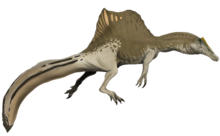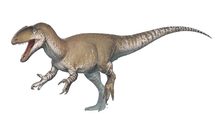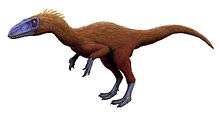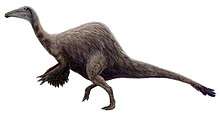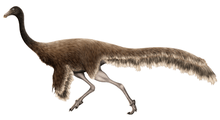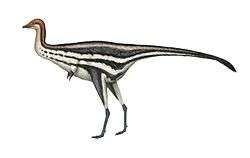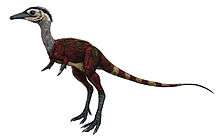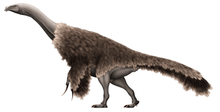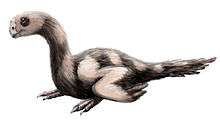Fukuiraptor
Fukuiraptor ("thief of Fukui") was a medium-sized megaraptoran theropod dinosaur of the Early Cretaceous epoch (either Barremian or Aptian) that lived in what is now Japan.[1]
| Fukuiraptor | |
|---|---|
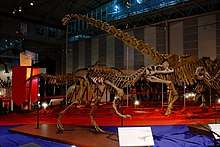 | |
| Reconstructed skeleton | |
| Scientific classification | |
| Kingdom: | Animalia |
| Phylum: | Chordata |
| Clade: | Dinosauria |
| Clade: | Saurischia |
| Clade: | Theropoda |
| Clade: | †Megaraptora |
| Genus: | †Fukuiraptor Azuma & Currie, 2000 |
| Type species | |
| †Fukuiraptor kitadaniensis Azuma & Currie, 2000 | |
Description and history
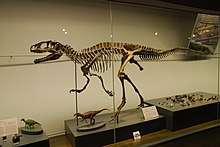
The type specimen is a partial skeleton (designated FPDM-V97122) discovered in the Kitadani quarry near Katsuyama in the Fukui prefecture. It is thought that this specimen, which would have measured about 4.2 metres long in life and weighed 175 kg, was not mature and an adult may have been larger. The remains of many other individuals have been found in the quarry, with numerous humeri, femurs, and teeth being assigned to this species.[2] However, the other individuals recovered from the same locality are mostly juveniles that were smaller than the holotype (Currie & Azuma, 2006), in the smallest case less than a quarter of the holotype's size. A tooth (NDC-P0001) discovered in a block of conglomerate from the Sebayashi Formation has been referred to Fukuiraptor as well.[3] In 2010 Gregory Paul gave a length of 5 meters (16 ft) and a weight of 300 kg (660 lbs).[4] Molina-Pérez and Larramendi estimated a length of 4.3 meters (14.1 ft) and a weight of 590 kg (1.300 lbs) in 2016.[5]
The distinctive teeth of Fukuiraptor show similarities with both carcharodontosaurids (being very compressed and blade-like, as well as having wrinkled enamel) and tyrannosaurids (having oblique blood grooves near the serrations).[2] The holotype also had very large and flat manual unguals (hand claws), which played a role in its initial classification as a dromaeosaurid (as the hand claws were mistaken for foot claws) as well as its current classification as a megaraptoran.[6]
An astragalus (NMV P150070) found in Australia, provisionally referred to Australovenator, may belong to a megaraptoran more closely related to Fukuiraptor due to being very similar to it.
Classification
Initially considered a member of the Dromaeosauridae when first discovered, its initial describers considered it a carnosaur, related to Allosaurus. More recent studies consider it a megaraptoran, an enigmatic group which may have been part of the family Neovenatoridae.[6] However, more recently, another analysis has proposed that all megaraptorans are actually tyrannosauroids, which would reclassify Fukuiraptor as a tyrannosauroid coelurosaur.[7] Recent cladistic analysis of the theropod Gualicho has suggested that Fukuiraptor and other megaraptorans are either allosauroids, or non-tyrannosauroid basal coelurosaurs.[8]
External links
- Image of the holotype skeleton, published by the twitter account of Thomas Holtz
- "Fukuiraptor kitadaniensis". Fukui Prefectural Dinosaur Museum. Archived from the original on 2006-08-29.
References
- Azuma, Yoichi; Philip J., Currie (2000). "A new carnosaur (Dinosauria: Theropoda) from the Lower Cretaceous of Japan". Canadian Journal of Earth Sciences. 37 (12): 1735–1753. Bibcode:2000CaJES..37.1735A. doi:10.1139/e00-064.
- Currie, P.J.; Azuma, Y. (2006). "New specimens, including a growth series, of Fukuiraptor (Dinosauria, Theropoda) from the Lower Cretaceous Kitadani Quarry of Japan". J. Paleont. Soc. Korea. 22 (1): 173–193 – via ResearchGate.
- Molnar, Ralph E.; Obata, Ikuwo; Tanimoto, Masahiro; Matsukawa, Masaki (2009). "A tooth of Fukuiraptor aff. F. kitadaniensis from the Lower Cretaceous Sebayashi Formation, Sanchu Cretaceous, Japan". Bulletin of Tokyo Gakugei University, Division of Natural Sciences. 61: 105–117 – via ResearchGate.
- Paul, Gregory S. (2010). The Princeton Field Guide to Dinosaurs. New Jersey: Princeton University Press. p. 98.
- Molina-Pérez & Larramendi (2016). Récords y curiosidades de los dinosaurios Terópodos y otros dinosauromorfos. Barcelona, Spain: Larousse. p. 263.
- Benson, R. B. J.; Carrano, M. T.; Brusatte, S. L. (2010). "A new clade of archaic large-bodied predatory dinosaurs (Theropoda: Allosauroidea) that survived to the latest Mesozoic". Naturwissenschaften. 97 (1): 71–78. Bibcode:2010NW.....97...71B. doi:10.1007/s00114-009-0614-x. PMID 19826771.
- Novas, F. E.; Agnolín, F. L.; Ezcurra, M. D.; Canale, J. I.; Porfiri, J. D. (2012). "Megaraptorans as members of an unexpected evolutionary radiation of tyrant-reptiles in Gondwana". Ameghiniana. 49 (4(R): Suplemento Resúmenes [Abstracts]): R33.
- Apesteguía, Sebastián; Smith, Nathan D.; Valieri, Rubén Juárez; Makovicky, Peter J. (2016-07-13). "An Unusual New Theropod with a Didactyl Manus from the Upper Cretaceous of Patagonia, Argentina". PLOS One. 11 (7): e0157793. Bibcode:2016PLoSO..1157793A. doi:10.1371/journal.pone.0157793. ISSN 1932-6203. PMC 4943716. PMID 27410683.



